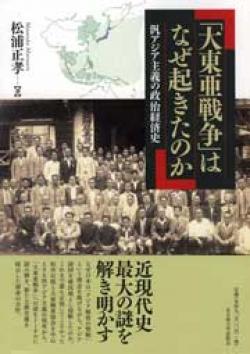Why Did the Greater East Asian War Happen?

Review by Ian Nish
In addressing the topic “how did the Greater East Asian War come about,?” Professor Matsuura focuses on the subject of pan-Asianism, but analyses its political and economic aspects rather than its ideological ones. In particular, he asks the question as set out on the dust jacket, “why did Japan, using the ideology of a holy war for the liberation of Asia, take over various countries as colonies?” and sets out to explain the “greatest riddle of recent history”: how pan-Asianism by its rise during the interwar period pushed Japan to confrontation with China, to southern expansion and ultimately towards what she liked to call “the Greater East Asian War,” virtually colonial war. It is an immense subject, covering commerce, politics and religion, and receives monumental treatment, about 1100 pages including endnotes of 200 pages. It is foolhardy of anyone to try to introduce such an encyclopaedic work, full of new materials and fresh insights, on what is inevitably a sensitive subject for the Japanese.
The author starts out by tracing the origins and development of ‘Asianism’ back to the nineteenth century and highlights the attitudes of Choshu, Satsuma and Saga clans towards relations with China and Korea. As a result of the intellectual ferment following the Russo-Japanese war, the scope of the Asian concept changed in line with the growth of Japan’s economic and military stature in the world. As the result of the failure of the racial equality resolution at the Paris peace conference of 1919 and the US anti-immigration legislation of the 1920s, its exponents began to speak of “Greater East Asia” and the Japanese state portrayed itself as “The Empire of the Seas.”
By the mid-thirties the Japanese economy had revived under the skilful management of Finance Minister Takahashi Korekiyo and gained ground on other countries still locked in the Great Depression. With the fall in the yen’s value, the author argues that Japanese goods swamped the markets of British India and other parts of the British Empire and, when Britain took steps to restrict this trade in the interests of Lancashire, this confirmed the pan-Asianists in their anti-colonial views. They could look to the merchant community for financial support for their movement. The author devotes a chapter to the activities of Indians who sought political exile in Japan, part of the diaspora of the British Empire. While the Japanese government trod a cautious path, those like Rashbehari Bose and A.M. Sahay obtained protection in various right-wing quarters until government itself recognized Subhas Chandra Bose as its preferred Indian leader in 1943.
A fascinating chapter tells of the attempts to integrate Manchukuo, which effectively became an economic protectorate of the Japanese after 1933, with other parts of China. Pan-Asianists believed that the colonial economies of Manchukuo, Korea and Taiwan had been successful – the tiger economies of the 1930s – and should be integrated into an Asian bloc. They hoped, with the collaboration of Chinese merchants around the area, to create an economic zone linking Taiwan with the adjacent mainland provinces of China (Fujian, Guangdong), areas largely in the hands of the Japanese military. The practical object behind this was to outflank the tactic of boycotting Japanese goods which Chinese merchants at the main ports were employing.
A large portion of the book is devoted to the activities of General Matsui Iwane and the Greater Asia Association (Dai Ajia Kyokai). Matsui who had been a Japanese officer specializing in Chinese affairs, became one of Japan’s top generals and was serving in General Staff roles at the beginning of the 1930s where his views were moulded by the Manchurian crisis. In 1933-4 he was appointed as commander-in-chief in the colony of Taiwan. There he hatched the idea of the Association and came to favour Japan expanding south (Nanshin) instead of north. He was a key figure in what was an influential group which was non-governmental and tended to include the army officers with a few civilians. As the international situation deteriorated, it became a powerful enough lobby that could exert pressure on any government. Recalled to the colours from retirement for the China war in 1937, Matsui was appointed commander of the Shanghai force which captured Shanghai and later Nanking, where atrocities were committed. He was immediately retired again and was ultimately condemned to death by the International Military Tribunal for the Far East for his connection with these atrocities.
Matsuura tries to analyse the independent thinking of right-wing groups like the Greater Asia Association and officers like Matsui. They were motivated by hostility to signs of racial discrimination and commercial restrictions against Japan. They tried by conferences and cultural activities both inside and outside Japan to make propaganda for an expanding role for Japan in Asia. As for government, there seems to have been in effect a tug-of-war between various factions. While some Japanese cabinets seem to have initially resisted and punished such views, they gradually came round to adopting pan-Asian doctrines in order to mobilize military and civilian opinion behind the war effort. Pan-Asianism was, the author believes, one factor which brought about the war by forming a bridge between Japan’s political dissatisfaction with the West and her growing expansionism in 1937 and 1941. But it could be argued that Japan merely used the ideological content of pan-Asianism to justify her continental, and ultimately hemispheric, expansion.
This is a masterly study, carefully based on documents and offering many new perspectives on the causes of the Greater East Asian War. It makes an important contribution to the debate which will continue to surround these years.
Ian Nish, STICERD, London School of Economics and Political Science

